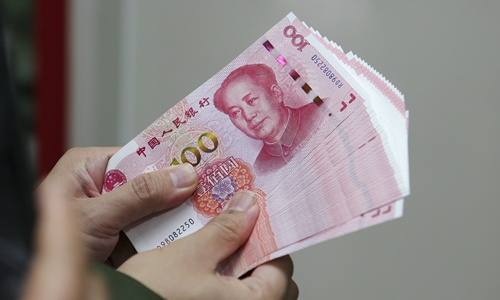
Renminbi Photo: VCG
The Chinese yuan became the most traded currency on the Moscow Exchange for the first time on Monday, with trading turnover in the yuan-ruble pair reaching 70.3 billion rubles ($1.17 billion), surpassing the 68.2 billion rubles for the dollar-ruble pair, according to a report from Russian informational agency RosBiznesConsulting (RBC) on Wednesday.
The report said a total of 64,900 transactions were made using the yuan-ruble pair, compared with 29,500 for the dollar-ruble pair on the same day. The yuan also overtook trading in the euro-ruble pair, which recorded a trading volume of 47.5 billion rubles.
The popular status of the Chinese yuan on the Moscow Exchange remained unchanged on Tuesday, with volume of trading for the yuan-ruble pair reaching 63.9 billion rubles (in total 46,000 transactions), and that of the dollar-ruble pair standing at 59.4 billion rubles (21,500 transactions) as of close, according to a report from China Central Television on Wednesday.
Yuan-denominated assets are gaining favor in the Russian market as bilateral trade has gained momentum over recent years. In the first eight months of 2022, trade between China and Russia totaled $117.2 billion, up 31.4 percent year-on-year, according to data from China's General Administration of Customs.
Shu Jueting, a Ministry of Commerce spokesperson, said on August 25 that bilateral trade between the two countries is maintaining strong growth momentum, and the two sides will continue to promote normal economic and trade exchanges and maintain stability of industrial and supply chains.
In early September, China and Russia reportedly signed
an agreement to switch trade payments for gas supplies to China to the yuan and the ruble based on a 50-50 split, instead of the dollar, paving the way for a more frequent ruble-yuan usage in bilateral trade.
Outside of Russia, the yuan has also been increasingly used in global trade and settlements amid the steady internationalization of yuan and bullish global views on the long-term development momentum of the Chinese economy.
According to data from global payment services the Society for Worldwide Interbank Financial Telecommunication (SWIFT), the Chinese yuan has retained its position as the fifth most active currency for global payments by value in August, accounting for a 2.31 percent share.
In August, the overall amount of payment made with yuan jumped 9.25 percent month-on-month, SWIFT data showed.
The latest report from IMF showed that the
Chinese yuan accounted for 2.88 percent of global foreign currency reserves in the second quarter of 2022, ranking fifth worldwide and maintaining its highest global reading since data was first released in 2016.
As the credibility and reputation of the US dollar system is at a higher risk of collapsing due to Washington's irresponsible monetary policy, de-dollarization is viewed as a forthcoming global trend, with more markets likely to recognize the yuan's internationalization trend over the long run, Chen Jia, a research fellow with the International Monetary Institute of the Renmin University of China, told the Global Times on Wednesday.
Global Times




